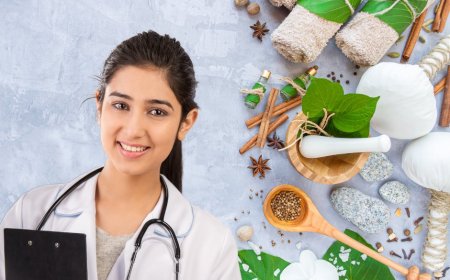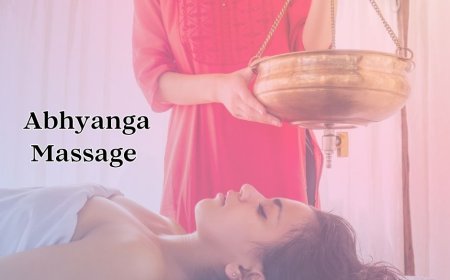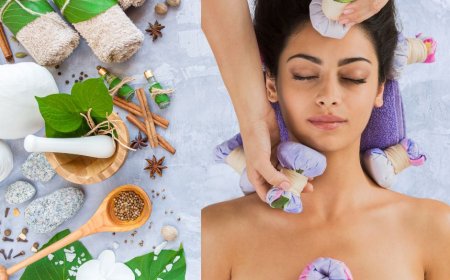The Ultimate Guide to Abhyanga Massage: Rejuvenate Your Mind, Body, and Soul
Discover the ancient practice of Abhyanga massage and experience the ultimate rejuvenation for your mind, body, and soul. This comprehensive guide has everything you need to know!

Abhyanga massage is an ancient practice derived from Ayurveda, the traditional Indian system of medicine. It is not just a massage technique, but a holistic approach to self-care and well-being. In this comprehensive guide, we will explore the origins and principles of Abhyanga, discuss its numerous benefits, and provide step-by-step instructions on how to perform this therapeutic massage on yourself or with a partner. Through the use of warm oils and rhythmic strokes, Abhyanga massage offers relaxation, stress relief, improved circulation, and emotional balance. Join us on this journey of self-discovery and unlock the transformative potential of Abhyanga massage.
History and Origins of Abhyanga Massage
Abhyanga massage has its roots in Ayurveda, the ancient Indian system of medicine that dates back thousands of years. The word "Abhyanga" is derived from Sanskrit, where "Abhi" means "to rub" and "Anga" means "limb". This traditional form of massage has been practiced for centuries in India as a way to promote overall well-being and restore balance to the body and mind.
The origins of Abhyanga can be traced back to ancient texts like the Charaka Samhita and the Sushruta Samhita, which are considered the foundational works of Ayurveda. These texts describe the techniques, benefits, and principles of Abhyanga massage, emphasizing its role in balancing the doshas (energies) of the body and promoting optimal health.
Abhyanga massage was traditionally performed using warm herbal oils specifically chosen based on an individual's dosha type. The rhythmic and flowing strokes of Abhyanga work to stimulate the lymphatic system, improve circulation, and release toxins from the body. This ancient practice not only nourishes the skin but also calms the nervous system, promotes better sleep, and enhances overall vitality.
Benefits of Abhyanga Massage
Abhyanga massage offers a wide range of benefits for both the physical and mental well-being. The warm oil used in Abhyanga penetrates deep into the tissues, lubricating the joints, nourishing the skin, and soothing the nervous system. Here are some of the key benefits of Abhyanga massage:
1. Relaxation and Stress Relief:
One of the primary benefits of Abhyanga massage is its ability to induce deep relaxation and reduce stress. The rhythmic strokes and warm oil help to calm the nervous system, release tension, and promote a sense of tranquility and well-being.
2. Improved Circulation: The gentle yet firm strokes of Abhyanga massage stimulate blood flow, improving circulation throughout the body. This helps to deliver fresh oxygen and nutrients to the cells while removing waste products and toxins.
3. Detoxification: Abhyanga massage aids in the detoxification process by stimulating the lymphatic system. The rhythmic movements and warm oil help to flush out toxins from the body, promoting overall health and vitality.
4. Enhanced Immunity: Regular Abhyanga massage can boost the immune system by increasing the production of white blood cells and improving lymphatic flow. This can help to prevent illness and promote faster healing.
5. Skin Nourishment: The warm herbal oils used in Abhyanga massage deeply nourish and moisturize the skin, leaving it soft, supple, and radiant. The oils penetrate the skin, promoting cellular regeneration and improving skin tone.
6. Emotional Balance: Abhyanga massage has a profound impact on the mind and emotions. The soothing strokes and warm oil help to release emotional blockages, reduce anxiety, and promote a sense of inner peace and harmony.
These are just a few of the many benefits that Abhyanga massage has to offer. Whether you are looking to relax, reduce stress, improve circulation, or promote overall well-being, Abhyanga can be a transformative practice for both the body and mind.
Techniques and Tools Used in Abhyanga Massage
Abhyanga massage involves a variety of techniques and tools that work together to create a deeply relaxing and therapeutic experience. Here are some of the key elements of Abhyanga massage:
1. Warm Herbal Oils: Central to Abhyanga massage is the use of warm herbal oils. These oils are carefully chosen based on an individual's dosha type and the desired outcome of the massage. The oils are heated to a comfortable temperature and applied generously to the body.
2. Rhythmic Strokes: The therapist uses a combination of long, flowing strokes and gentle kneading motions to massage the body. The strokes are rhythmic and continuous, creating a sense of harmony and balance.
3. Marma Points: Marma points are vital energy points located throughout the body. During Abhyanga massage, the therapist may focus on specific marma points to release any blockages and restore the flow of energy.
4. Synchronized Movements: In some traditional forms of Abhyanga massage, two therapists work in sync to perform the massage. This synchronized approach enhances the therapeutic effects and creates a deeply relaxing experience.
5. Herbal Powders and Pastes: In addition to warm oils, the therapist may also use herbal powders or pastes to exfoliate and cleanse the skin. These powders are often made from a combination of herbs, grains, and natural ingredients.
These techniques and tools are carefully chosen to create a unique and personalized Abhyanga experience. Whether you are receiving a professional massage or performing self-Abhyanga at home, these elements work together to promote balance, relaxation, and well-being.
Preparing for an Abhyanga Massage
Before you begin your Abhyanga massage, it is important to create a relaxing and nurturing environment. Here are a few tips to help you prepare for your massage:
1. Choose a Comfortable Space: Find a quiet, comfortable space where you can perform the massage without interruptions. Ideally, this space should be warm, clean, and free from distractions.
2. Set the Mood: Create a soothing atmosphere by dimming the lights, playing soft music, and using aromatherapy diffusers or candles. Choose scents like lavender or chamomile, which promote relaxation and calmness.
3. Prepare the Oils: Heat the chosen herbal oil to a comfortable temperature. You can do this by placing the oil bottle in a bowl of warm water for a few minutes. Test the temperature on your wrist to ensure it is not too hot.
4. Get Comfortable: Wear loose, comfortable clothing that can be easily removed. You may also want to lay down a towel or mat to protect the surface you will be lying on.
5. Set Aside Time: Abhyanga massage is best enjoyed when you have enough time to fully relax and savor the experience. Set aside at least 30 minutes to an hour for your massage, allowing yourself to fully immerse in the therapeutic benefits.
By preparing for your Abhyanga massage, you are setting the stage for a deeply rejuvenating and transformative experience. Now that you are ready, let's move on to the step-by-step guide on how to perform self-Abhyanga massage.
Step-by-Step Guide to Performing Self-Abhyanga Massage
Self-Abhyanga massage is a wonderful way to connect with your body, nurture yourself, and promote overall well-being. Here is a step-by-step guide to help you perform self-Abhyanga at home:
1. Prepare the Space: Find a quiet and comfortable space where you can perform the massage without interruptions. Lay down a towel or mat to protect the surface you will be sitting or lying on.
2. Choose the Right Oil: Select a warm herbal oil that is suitable for your dosha type or desired outcome. Pour a generous amount of oil into a small bowl or container that you can easily access during the massage.
3. Begin with Warm-Up: Start by warming up your body. Rub the oil between your palms to warm it up and then apply it to your scalp using circular motions. Massage your scalp for a few minutes, allowing the oil to nourish your hair and relax your mind.
4. Move to the Face: Gently massage your face using upward strokes. Pay attention to the forehead, temples, cheeks, and jawline. Use gentle pressure and circular motions to release any tension and promote a sense of relaxation.
5. Massage the Neck and Shoulders: Apply more oil to your hands and massage your neck and shoulders using long, flowing strokes. Use your fingertips to apply gentle pressure to any areas of tension or discomfort.
6. Move to the Arms: Massage each arm separately, starting with the upper arm and moving down to the fingertips. Use long, rhythmic strokes and kneading motions to release tension and improve circulation.
7. Focus on the Chest and Abdomen: Apply oil to your chest and abdomen and massage using gentle, circular motions. Take slow, deep breaths as you massage these areas, allowing the oil to penetrate and nourish your skin.
8. Move to the Legs: Massage each leg separately, starting with the thigh and moving down to the feet. Use long, flowing strokes and kneading motions to release tension and promote relaxation.
9. Finish with the Feet: Apply oil to your feet and massage using your hands or a foot roller. Pay attention to the soles of your feet, applying pressure to specific points to relieve any discomfort or tension.
10. Rest and Absorb: After you have completed the massage, take a moment to rest and absorb the therapeutic benefits. Wrap yourself in a warm towel or blanket and relax for at least 15-30 minutes, allowing the oil to deeply penetrate your skin.
Performing self-Abhyanga massage on a regular basis can be a powerful practice for self-care and well-being. It allows you to reconnect with your body, soothe your mind, and promote overall balance and vitality.
Finding a Professional Abhyanga Massage Therapist
While performing self-Abhyanga massage can be a rewarding experience, there is also great value in receiving a professional Abhyanga massage. A skilled therapist can provide deeper relaxation, personalized guidance, and a more comprehensive experience. Here are a few tips to help you find a professional Abhyanga massage therapist:
1. Research Ayurvedic Spas: Look for spas or wellness centers that specialize in Ayurveda or offer Abhyanga massage. These establishments are more likely to have trained and experienced therapists who are well-versed in the principles and techniques of Abhyanga.
2. Read Reviews and Testimonials: Before booking a session, read reviews and testimonials from previous clients. This can give you insights into the quality of the therapists and the overall experience at the spa or wellness center.
3. Ask for Recommendations: Reach out to friends, family, or colleagues who have had Abhyanga massage and ask for their recommendations. Personal referrals can be valuable in finding a trusted and skilled therapist.
4. Inquire about Training and Certification: When you call or visit a spa or wellness center, inquire about the training and certification of their therapists. A reputable establishment will have therapists who have undergone formal training in Ayurveda and Abhyanga massage.
5. Schedule a Consultation: If possible, schedule a consultation with the therapist before booking a session. This will allow you to discuss your specific needs and expectations and ensure that the therapist is a good fit for you.
By finding a professional Abhyanga massage therapist, you can enhance your experience and receive the full benefits of this ancient practice. Remember to communicate your needs and preferences to the therapist, ensuring that the session is personalized and tailored to your unique requirements.
Ayurvedic Oils and Herbs Used in Abhyanga Massage
Central to Abhyanga massage is the use of warm herbal oils, carefully chosen based on an individual's dosha type or specific needs. These oils are infused with a variety of Ayurvedic herbs and ingredients, each with its own unique therapeutic properties. Here are some common Ayurvedic oils and herbs used in Abhyanga massage:
1. Sesame Oil: Sesame oil is one of the most commonly used oils in Abhyanga massage. It is nourishing, warming, and helps to balance all three doshas. Sesame oil is also known for its anti-inflammatory and detoxifying properties.
2. Coconut Oil: Coconut oil is cooling, soothing, and moisturizing. It is particularly beneficial for Pitta dosha types or those with sensitive skin. Coconut oil is also antimicrobial, making it ideal for promoting healthy skin.
3. Almond Oil: Almond oil is nourishing, calming, and beneficial for all dosha types. It is rich in vitamins and minerals, promoting healthy skin and improving complexion. Almond oil is also known for its anti-aging properties.
4. Bhringaraj Oil: Bhringaraj oil is commonly used in Abhyanga massage for its rejuvenating and revitalizing properties. It nourishes the hair and scalp, promotes hair growth, and helps to calm the mind and nervous system.
5. Ashwagandha Oil: Ashwagandha oil is known for its stress-relieving and rejuvenating properties. It helps to calm the mind, reduce anxiety, and promote a sense of relaxation and well-being.
6. Turmeric: Turmeric is a powerful antioxidant and anti-inflammatory herb. It helps to purify the skin, improve complexion, and reduce inflammation. Turmeric is often included in Ayurvedic oils used for Abhyanga massage.
These are just a few examples of the many oils and herbs used in Abhyanga massage. The specific combination of oils and herbs will vary depending on an individual's dosha type or desired outcome. When choosing an Ayurvedic oil for your massage, consult with an Ayurvedic practitioner or a trained therapist to ensure that it is suitable for your needs.
Frequently Asked Questions about Abhyanga Massage
What is Abhyanga massage?
Answer: Abhyanga massage is a traditional Ayurvedic massage technique that involves the use of warm oil and long, sweeping strokes to promote relaxation and balance in the body. It is believed to help improve circulation, detoxify the body, reduce stress, and enhance overall well-being.
What are the benefits of Abhyanga massage?
Answer: Abhyanga massage, an ancient Ayurvedic practice, offers numerous benefits. It helps to relax the body and mind, reduce stress and anxiety, improve blood circulation, detoxify the body, nourish the skin, and promote overall well-being. It also helps to balance the doshas (energies) in the body and enhance the immune system.
What are the different types of Abhyanga massage?
Answer: There are several different types of Abhyanga massage.
What are the oils used in Abhyanga massage?
Answer: Abhyanga massage, a traditional Ayurvedic practice, typically uses warm oils that are specifically chosen based on the individual's dosha (body type). Some common oils used in Abhyanga massage include sesame oil, coconut oil, almond oil, and jojoba oil. These oils are believed to nourish the skin, promote relaxation, and balance the doshas.
How Often Should You Do Abhyanga Massage?
Answer: It is recommended to perform Abhyanga massage at least once a week for optimal benefits. However, you can also do it more frequently if desired or if you have specific health concerns. It is best to consult with a qualified Ayurvedic practitioner for personalized advice.
What are the contraindications for Abhyanga massage?
Answer: Some contraindications for Abhyanga massage include fever, acute illness, infectious skin conditions, open wounds, recent surgery, pregnancy, and certain medical conditions such as cancer or cardiovascular disease. It is important to consult with a qualified practitioner before receiving an Abhyanga massage to ensure it is safe for you.
How to do Abhyanga massage at home?
Answer: To do Abhyanga massage at home, start by warming up some oil and applying it to your body. Use long, sweeping strokes and apply gentle pressure. Focus on massaging each body part, starting from your head and working your way down to your feet. Take your time and enjoy the relaxing benefits of this self-care practice.
What's Your Reaction?





























